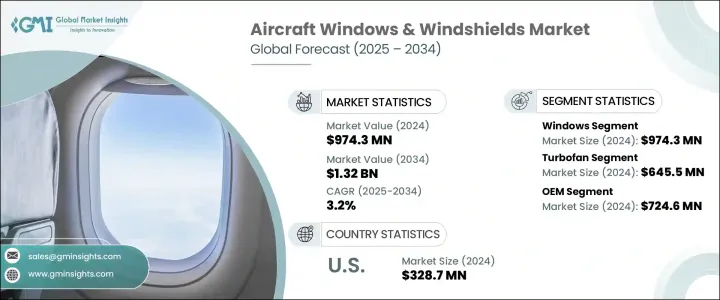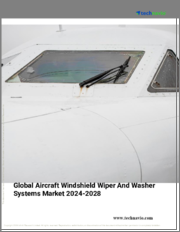
|
시장보고서
상품코드
1750299
세계의 항공기 창문 및 윈드실드 시장 : 기회, 촉진요인, 산업 동향 분석, 예측(2025-2034년)Aircraft Windows and Windshields Market Opportunity, Growth Drivers, Industry Trend Analysis, and Forecast 2025 - 2034 |
||||||
세계의 항공기 창문 및 윈드실드 시장은 2024년 9억 7,430만 달러였고, 민간 항공기와 비즈니스 항공기의 생산과 배치가 증가하고, 고급 창문 시스템에 대한 수요가 지속되고 있기 때문에 CAGR 3.2%로 성장하여 2034년에는 13억 2,000만 달러에 달할 것으로 예측됩니다.
새로운 항공기의 플랫폼과 리노베이션이 가볍고 내충격성이 있는 소재로의 이동을 촉진하는 한편, 승객의 쾌적성과 에너지 효율은 신제품 개발에 있어서 계속 중요한 고려사항이 되고 있습니다.

최근 무역 정책이 제조 전략에 영향을 미치고 있습니다. 알루미늄과 특수 유리와 같은 중요한 원재료에 대한 관세 도입은 특히 북미에서 최대 15%의 제조 비용 상승으로 이어졌습니다. 재료 과학의 개발은 뛰어난 항공기 창 및 윈드실드의 개발을 뒷받침하고 있습니다. 친환경 코팅 등의 기술은 가혹한 조건 하에서의 성능 향상을 위해 주목을 받고 있습니다. 자가 복구 필름, 임베디드 센서, 스마트 착색 기능은 에너지 사용을 최적화하는 동시에 기내의 체험을 일변시킵니다.
| 시장 범위 | |
|---|---|
| 시작 연도 | 2024년 |
| 예측 연도 | 2025-2034년 |
| 시작 금액 | 9억 7,430만 달러 |
| 예측 금액 | 13억 2,000만 달러 |
| CAGR | 3.2% |
제품별로 항공기 창문 부문이 2024년에 9억 7,430만 달러를 만들어 냈습니다. 폴리카보네이트를 기반으로 하는 선진적인 대체품으로 꾸준히 이행하고 있습니다.
항공기 창문과 앞 유리 시장의 터보 팬 부문은 고성능 다층 창문이 까다로운 열 그라디언트, 고도 압력, 잠재적 조류 충돌을 견디기 때문에 2024년 시장 규모는 6억 4,550만 달러에 달했습니다. 제빙 기능과 온도 조정 기능을 내장한 첨단 윈드스크린을 사용하고 있습니다.
2024년 미국 항공기 창문과 앞 유리 시장은 주요 제조 기지, 대규모 항공기 함대, 견고한 정비, 수리 및 오버홀(MRO) 생태계를 통해 3억 2,870만 달러 에 이르렀습니다. 군사 조달 프로그램은 엄격한 FAA 규정 준수 기준과 함께 방어 및 상업 부문에 걸쳐 내구성이 있으며 경량이며 기술적으로 고급 재료에 대한 수요를 계속 추진하고 있습니다.
세계 항공기용 창문 및 윈드스크린 시장의 주요 기업으로는 Saint-Gobain Aerospace, The NORDAM Group LLC, GENTEX Corporation, GKN Aerospace, PPG Industries, Inc.등이 있습니다. 항공기용 창문 및 윈드스크린 시장의 주요 기업은 기술 제휴, 시설의 확장을 통해 그 지위를 강화하고 있습니다. 내충격성, 경량 솔루션의 개발 노력은 엄격한 FAA와 EASA의 요구 사항을 충족하는 데 도움이 됩니다.
목차
제1장 조사 방법과 범위
제2장 주요 요약
제3장 업계 인사이트
- 생태계 분석
- 트럼프 정권의 관세 분석
- 무역에 미치는 영향
- 무역량의 혼란
- 보복 조치
- 업계에 미치는 영향
- 공급측의 영향
- 가격 변동
- 공급망 재구성
- 생산 비용에 미치는 영향
- 수요측의 영향
- 최종 시장에의 가격 전달
- 시장 점유율 동향
- 소비자의 반응 패턴
- 공급측의 영향
- 영향을 받는 주요 기업
- 전략적인 업계 대응
- 공급망 재구성
- 가격 설정 및 제품 전략
- 정책관여
- 전망과 향후 검토 사항
- 무역에 미치는 영향
- 업계에 미치는 영향요인
- 성장 촉진요인
- 항공기의 납품과 기체수의 확대
- 재료 및 코팅의 기술적 진보
- 방위 및 군용 항공기의 근대화의 진전
- 노후화된 항공기와 MRO 증가에 의해 애프터마켓 수요가 증가
- 업계의 잠재적 위험 및 과제
- 높은 인증 비용
- 공급망의 혼란
- 성장 촉진요인
- 성장 가능성 분석
- 규제 상황
- 기술의 상황
- 장래 시장 동향
- 갭 분석
- Porter's Five Forces 분석
- PESTEL 분석
제4장 경쟁 구도
- 소개
- 기업의 시장 점유율 분석
- 주요 시장 기업의 경쟁 분석
- 경쟁 포지셔닝 매트릭스
- 전략 대시보드
제5장 시장 추계 및 예측 : 제품 유형별, 2021-2034년
- 주요 동향
- 창문
- 윈드실드
제6장 시장 추계 및 예측 : 기종별, 2021-2034년
- 주요 동향
- 터보프롭
- 터보팬
- 터보 제트
- 터보샤프트
제7장 시장 추계 및 예측 : 최종 용도별, 2021-2034년
- 주요 동향
- OEM
- 애프터마켓
제8장 시장 추계 및 예측 : 지역별, 2021-2034년
- 주요 동향
- 북미
- 미국
- 캐나다
- 유럽
- 독일
- 영국
- 프랑스
- 스페인
- 이탈리아
- 네덜란드
- 아시아태평양
- 중국
- 인도
- 일본
- 호주
- 한국
- 라틴아메리카
- 브라질
- 멕시코
- 아르헨티나
- 중동 및 아프리카
- 사우디아라비아
- 남아프리카
- 아랍에미리트(UAE)
제9장 기업 프로파일
- Control Logistics Inc
- GENTEX CORPORATION
- GKN Aerospace
- Lee Aerospace
- Llamas Plastics Inc.
- LP Aero Plastics Inc.
- Perkins Aircraft Windows
- PPG Industries, Inc.
- Saint-Gobain Aerospace
- The NORDAM Group LLC
The Global Aircraft Windows and Windshields Market was valued at USD 974.3 million in 2024 and is estimated to grow at a CAGR of 3.2% to reach USD 1.32 billion by 2034, driven by the rising production and deployment of both commercial and business aircraft with sustained demand for advanced window systems. New aircraft platforms and retrofits are driving the shift toward lightweight, impact-resistant materials, while passenger comfort and energy efficiency remain essential considerations in new product development. As the industry adapts to stricter regulatory guidelines, material innovations and evolving aerodynamics are shaping next-generation designs.

Trade policies have influenced manufacturing strategies in recent years. The introduction of tariffs on critical raw materials like aluminium and specialty glass led to production cost hikes of up to 15%, particularly in North America. These shifts prompted a realignment of global supply chains and created cost advantages for some international manufacturers. Additionally, aftermarket vendors saw cost pressures due to their reliance on imported components. Such geopolitical tensions have intensified cost sensitivities across the supply and distribution network. Advancements in material science are propelling the development of superior aircraft windows and windshields. Technologies such as polycarbonate laminates, electrochromic dimming systems, and graphene-infused coatings are gaining prominence for enhancing performance in extreme conditions. Self-healing films, embedded sensors, and smart-tinting functions transform cabin experiences while optimizing energy use.
| Market Scope | |
|---|---|
| Start Year | 2024 |
| Forecast Year | 2025-2034 |
| Start Value | $974.3 Million |
| Forecast Value | $1.32 Billion |
| CAGR | 3.2% |
In the product category breakdown, the aircraft windows segment generated USD 974.3 million in 2024. These components are engineered not only for visibility but also to handle extreme pressure differentials, temperature shifts, and impact scenarios. The industry is steadily shifting toward advanced polycarbonate-based alternatives to lighten aircraft weight and enhance fuel efficiency, without compromising structural resilience. While the transition demands high R&D and certification costs due to strict aviation authority standards, these investments are justified by improvements in performance, lifecycle reliability, and regulatory compliance.
The turbofan segment in the aircraft windows & windshields market was valued at USD 645.5 million in 2024 as high-performance, multi-layered windows withstand severe thermal gradients, high-altitude pressures, and potential bird impacts. Many new-generation aircraft use advanced windshields with built-in de-icing and thermal regulation features to ensure pilot visibility and cockpit safety. As fleets expand, OEM shipments are gaining momentum, while the aftermarket remains active due to increasing demand for windshield replacements and upgrades in older airframes.
United States Aircraft Windows & Windshields Market reached USD 328.7 million in 2024, owing to key manufacturing hubs, large aircraft fleets, and a solid maintenance, repair, and overhaul (MRO) ecosystem. Military procurement programs, along with rigorous FAA compliance standards, continue to drive the demand for durable, lightweight, and technically advanced materials across both defense and commercial sectors.
Leading players in the Global Aircraft Windows & Windshields Market include Saint-Gobain Aerospace, The NORDAM Group LLC, GENTEX Corporation, GKN Aerospace, and PPG Industries, Inc. Key players in the aircraft windows & windshields market are strengthening their positions through technology partnerships, facility expansions, and material innovation. Companies invest heavily in smart window systems that enhance comfort and performance, especially in the premium and defense segments. Strategic collaborations with OEMs help ensure early integration of products into new platforms, while efforts to develop impact-resistant, lightweight solutions help meet strict FAA and EASA requirements. Major manufacturers localize supply chains to mitigate tariff impacts and improve lead times. R&D remains a core strategy, with firms focusing on electro-optic upgrades, anti-icing enhancements, and new composite structures that reduce lifecycle costs and weight.
Table of Contents
Chapter 1 Methodology and Scope
- 1.1 Market scope and definitions
- 1.2 Research design
- 1.2.1 Research approach
- 1.2.2 Data collection methods
- 1.3 Base estimates and calculations
- 1.3.1 Base year calculation
- 1.3.2 Key trends for market estimation
- 1.4 Forecast model
- 1.5 Primary research and validation
- 1.5.1 Primary sources
- 1.5.2 Data mining sources
Chapter 2 Executive Summary
- 2.1 Industry 3600 synopsis
Chapter 3 Industry Insights
- 3.1 Industry ecosystem analysis
- 3.2 Trump administration tariffs analysis
- 3.2.1 Impact on trade
- 3.2.1.1 Trade volume disruptions
- 3.2.1.2 Retaliatory measures
- 3.2.1.3 Impact on the industry
- 3.2.1.3.1 Supply-side impact
- 3.2.1.3.1.1 Price volatility
- 3.2.1.3.1.2 Supply chain restructuring
- 3.2.1.3.1.3 Production cost implications
- 3.2.1.3.2 Demand-side impact
- 3.2.1.3.2.1 Price transmission to end markets
- 3.2.1.3.2.2 Market share dynamics
- 3.2.1.3.2.3 Consumer response patterns
- 3.2.1.3.1 Supply-side impact
- 3.2.1.4 Key companies impacted
- 3.2.1.5 Strategic industry responses
- 3.2.1.5.1 Supply chain reconfiguration
- 3.2.1.5.2 Pricing and product strategies
- 3.2.1.5.3 Policy engagement
- 3.2.1.6 Outlook and future considerations
- 3.2.1 Impact on trade
- 3.3 Industry impact forces
- 3.3.1 Growth drivers
- 3.3.1.1 Increasing aircraft deliveries and fleet expansion
- 3.3.1.2 Technological advancements in materials and coatings
- 3.3.1.3 Rising defense and military aircraft modernization
- 3.3.1.4 Aftermarket demand driven by aging fleets and MRO growth
- 3.3.2 Industry pitfalls and challenges
- 3.3.2.1 High certification costs
- 3.3.2.2 Supply chain disruptions
- 3.3.1 Growth drivers
- 3.4 Growth potential analysis
- 3.5 Regulatory landscape
- 3.6 Technology landscape
- 3.7 Future market trends
- 3.8 Gap analysis
- 3.9 Porter's analysis
- 3.10 PESTEL analysis
Chapter 4 Competitive Landscape, 2024
- 4.1 Introduction
- 4.2 Company market share analysis
- 4.3 Competitive analysis of major market players
- 4.4 Competitive positioning matrix
- 4.5 Strategy dashboard
Chapter 5 Market Estimates & Forecast, By Product Type, 2021-2034 (USD Million & Units)
- 5.1 Key trends
- 5.2 Windows
- 5.3 Windshields
Chapter 6 Market Estimates & Forecast, By Aircraft Type, 2021-2034 (USD Million & Units)
- 6.1 Key trends
- 6.2 Turboprop
- 6.3 Turbofan
- 6.4 Turbojet
- 6.5 Turboshaft
Chapter 7 Market Estimates & Forecast, By End Use, 2021-2034 (USD Million & Units)
- 7.1 Key trends
- 7.2 OEM
- 7.3 Aftermarket
Chapter 8 Market Estimates and Forecast, By Region, 2021-2034 (USD Million & Units)
- 8.1 Key trends
- 8.2 North America
- 8.2.1 U.S.
- 8.2.2 Canada
- 8.3 Europe
- 8.3.1 Germany
- 8.3.2 UK
- 8.3.3 France
- 8.3.4 Spain
- 8.3.5 Italy
- 8.3.6 Netherlands
- 8.4 Asia Pacific
- 8.4.1 China
- 8.4.2 India
- 8.4.3 Japan
- 8.4.4 Australia
- 8.4.5 South Korea
- 8.5 Latin America
- 8.5.1 Brazil
- 8.5.2 Mexico
- 8.5.3 Argentina
- 8.6 Middle East and Africa
- 8.6.1 Saudi Arabia
- 8.6.2 South Africa
- 8.6.3 UAE
Chapter 9 Company Profiles
- 9.1 Control Logistics Inc
- 9.2 GENTEX CORPORATION
- 9.3 GKN Aerospace
- 9.4 Lee Aerospace
- 9.5 Llamas Plastics Inc.
- 9.6 LP Aero Plastics Inc.
- 9.7 Perkins Aircraft Windows
- 9.8 PPG Industries, Inc.
- 9.9 Saint-Gobain Aerospace
- 9.10 The NORDAM Group LLC


















